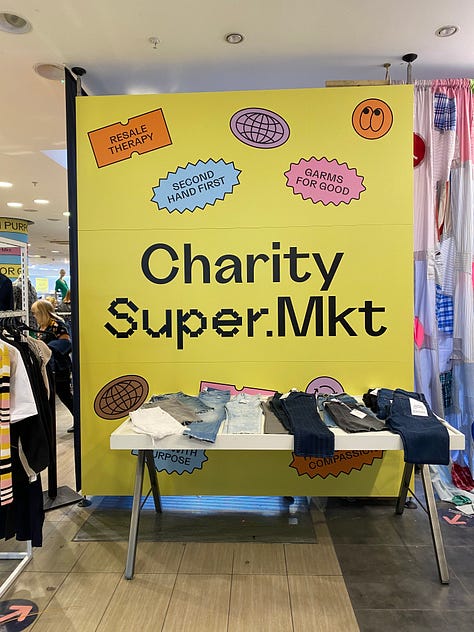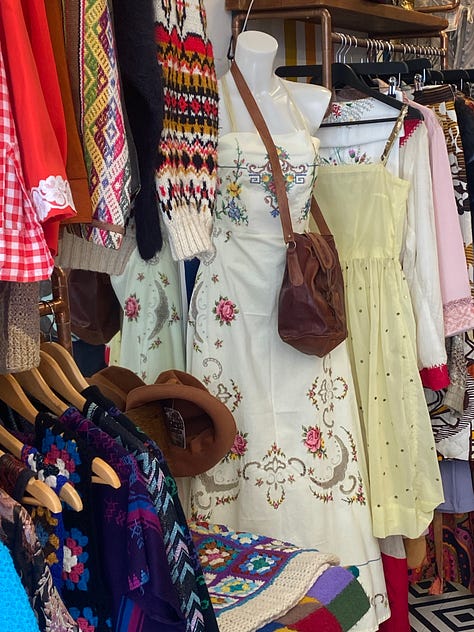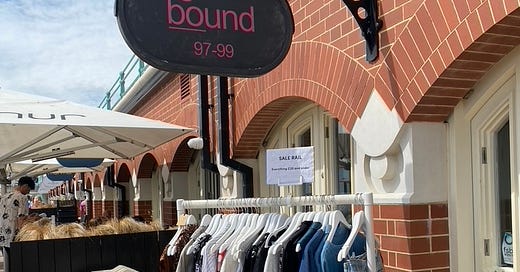Can the growing secondhand market reduce fashion's carbon emisssions?
The fashion industry needs to halve its carbon emissions by 2030 to stay in line with the Paris Climate Accord targets; can shopping secondhand contribute to these reductions, and if so how?
Do you see secondhand fashion everywhere you go? Whether that’s the Charity stores taking over our empty high streets, or the vintage sellers taking over Instagram or the big resale platforms taking over our advertising hoardings; the spotlight is on the secondhand market. Encouraging this focus is a pervasive story in the press, and on social media, telling us that buying secondhand clothes is the most environmentally friendly thing to do and that selling preloved clothes is a money making opportunity for fashion brands, entrepreneurial individuals and institutional investors alike.
So, with ThredUp predicting the global secondhand market will almost double in size over the next three years, does this mean fashion’s carbon emissions should start to fall?



How can secondhand shopping reduce carbon emissions?
I’ve spent the last eighteen months investigating this question while completing an MA in Fashion Futures at London College of Fashion and this feed is designed as a way to share what I’ve discovered.
The good news is that for us, as individual consumers, choosing to buy secondhand apparel rather than buying something new could reduce our own personal carbon footprints. To find out more about your impact, and how you can reduce your emissions take a look at the WWF footprint calculator here.
But, for the growing secondhand market to make a meaningful difference to the fashion industry’s overall emissions, preloved purchases need to start to displace new purchases and the overall number of new clothes that brands are making needs to start to reduce.
In this context the term displacement is defined as the direct replacement of an item of new clothing with a secondhand item, which removes the need to manufacture the new item. And displacement matters because, according to McKinsey and Company’s “Fashion on Climate” Report, the vast majority of the fashion’s emissions happen when new raw materials, fabrics and garments are produced, and research by the Ellen MacArthur Foundation shows that if a new dress is worn twenty times, then resold twice, and reworn another forty times, its lifetime carbon emissions would be halved.
Most experts seem to agree that making fewer new clothes, and rewearing what’s already been made instead, is the most straightforward way to reduce fashion’s emissions.
The elephant in the room is…
But, the elephant in the room is that, as the recent Re/make Fashion Accountability Report says, “despite the meteoric rise of resale, none of the companies we evaluated that have resale programs in place demonstrated that they are, in tandem, reducing the production of new products.”
In fact, as Adam Minter’s highly readable book “Secondhand; Travels in the New Global Garage Sale” reveals the ability to resell or donate our unwanted apparel in easy, and relatively guilt free ways, could even be encouraging people to buy more new clothes. So, paradoxically, the growing secondhand market may be increasing shopping and wardrobe churning, rather than displacing new purchases.
Countering this is consumer research from FarFetch and DePop suggesting that secondhand purchases displaced new purchases between 65% and 92% of the time for the shoppers they surveyed. While this sounds positive, asking people whether their secondhand purchases are displacing new apparel purchases isn’t an accurate measurement, and their answers may be distorted by good intentions. However, it is the only information we have because displacement is not targeted, tracked or measured across the fashion industry and the secondhand market.
What’s the problem?
As the The Or Foundation’s “Speak Volumes” campaign highlights, there is no way of knowing how many new garments are being produced. It’s estimated that somewhere between 80 and 150 billion new apparel items are being manufactured every year and when you start investigating the secondhand market most of the available information talks about sales revenues or tonnages rather than actual items of clothing.
Plus, the secondhand market is complex and fragmented; encompassing resale platforms, social commerce, markets and online marketplaces, charity stores, consignment stores, the vast global export market and countless peer to peer transactions, many of which are undocumented.
New technology, particularly digital product passports, could be transformative in measuring displacement and some brands, in particular Patagonia, are already talking about reducing their new production volumes. I’ll be sharing more about this in future posts.
What can we do?
The Or Foundation estimates 23.63 billion items of secondhand clothing are being resold and recirculated every year and the big question is how can this start to reduce the new production of new clothes ?
As individuals can’t we just shop secondhand instead of new? Possibly. But, as I’m learning in my own personal experiment to choose secondhand first, while browsing for secondhand treasure may be fun, finding something specific in your size when you need it is hard work and not always possible.
And even though more people are buying secondhand apparel, the mainstream fashion industry is still predicting growth in revenues, particularly at the lower end of the market, which likely means brands are likely to be producing more and more new stuff to maintain sales revenues rather than reducing their production numbers.
Through my research I’ve come to believe that although displacement is theoretically possible as a route to reducing fashion’s carbon emissions, measuring displacement will require unprecedented transparency and collaboration between the mainstream fashion industry and the secondhand market; and achieving displacement will probably require a focus on reducing our overall purchases of both secondhand and new apparel.
The question is are we, as individuals and as a fashion industry, up for the challenge?
What do you think?
I’ve started this Substack as a way to start conversations about displacement and continue my research into how the secondhand market can be a lever to reducing fashion’s carbon emissions so please tell me what you think and suggest topics I should investigate.



Step by step we go… educate & evolve our perception of what’s “necessary”, what’s beautiful & what’s aspirational or symbolic of success & worth.
I can’t imagine that if we truly understood what was at stake that we’d continue to consume or manufacture & manipulate as we do.
We all need to be informed & benevolent with our intentions & recognize our interconnectedness.
May we all do better, together.
Hi Gemma,
Very interesting post, thank you. Two thoughts;
1) If the fashion industry see a slow down in purchase from their usual market group, will they simply start to look for other markets to move into, in order to continue production at a high level, especially if they can side step some of the ethical issues at the same time.
2) You mention that it can be hard to find the right garment in the right size when shopping secondhand, but this is often why people start shopping secondhand, because they can't find what they want in their size or that fits their identity, within mainstream fashion. An added bonus is that if you can sew and do a few alterations, you can make things fit better, or update them to represent your own style. Your point, while very valid can actually work both ways.